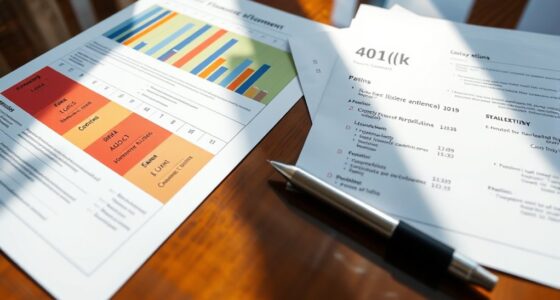To create a retirement budget that withstands inflation, you should start by evaluating your current expenses and estimating future costs, including rising healthcare and daily living expenses. Incorporate inflation projections based on historical data and economic forecasts, and diversify your income sources with inflation-resistant investments like TIPS or real estate. Regularly review your budget with the latest tools and adjust your plans as economic conditions change. Continuing with the details will help guarantee your savings last.
Key Takeaways
- Incorporate inflation projections into your annual budget to ensure expenses are accurately anticipated and covered over time.
- Diversify income sources and invest in inflation-resistant assets like TIPS, real estate, and commodities to preserve purchasing power.
- Regularly review and adjust your budget and savings plans to adapt to changing inflation rates and economic conditions.
- Track current spending patterns and identify unnecessary expenses to free up funds for inflation hedge investments.
- Use financial tools and calculators to model future costs and optimize withdrawal strategies, maintaining budget resilience against inflation.
Understanding the Impact of Inflation on Retirement Savings

Inflation can substantially erode the purchasing power of your retirement savings over time, making it essential to understand its impact. As costs rise, your savings might not stretch as far, especially without proper planning. To combat this, you should explore effective retirement tax strategies that can help preserve your funds and reduce your tax burden. Additionally, healthcare cost planning becomes vital because medical expenses tend to increase faster than general inflation. By factoring in these elements, you can create a more resilient retirement budget. Recognizing inflation’s influence allows you to adjust your savings and investment strategies proactively, ensuring your money lasts longer. Staying informed about inflation’s effects helps you make smarter financial decisions, giving you peace of mind in your retirement years.
Assessing Your Current Expenses and Future Needs

To effectively plan for your retirement, you need a clear picture of your current expenses and how they might change over time. Review your regular costs, like housing, healthcare, food, and transportation, to understand your baseline. Consider how your retirement lifestyle could alter these expenses—will travel increase, or will healthcare needs grow? Think about future expenditures, such as long-term care or hobbies, that may arise. Tracking your spending now helps identify patterns and areas where you can cut costs if needed. This assessment forms the foundation for creating a realistic retirement budget. By understanding what you spend today and how your needs might evolve, you can better prepare financially for a stable, comfortable retirement.
Incorporating Inflation Projections Into Your Budget

Since expenses tend to rise over time, incorporating inflation projections into your retirement budget is essential. Accurate inflation forecasting helps you plan for future costs, ensuring your savings last. Use historical data and expert predictions to adjust your budget annually. This proactive approach keeps you prepared for rising healthcare, housing, and daily expenses. Consider this emotional impact:
| Peace of Mind | Financial Security |
|---|---|
| Confidence in future expenses | Ability to enjoy retirement without worries |
| Knowing your plan adjusts | Staying ahead of inflation’s effects |
Diversifying Income Streams for Greater Stability

Diversifying your income streams is a crucial strategy to enhance financial stability in retirement. Relying solely on one source, like Social Security or a pension, exposes you to risks if those payments decrease or stop. By incorporating alternative income sources, you create a safety net that cushions against market fluctuations and inflation. Passive earnings, such as rental income or dividends, require less ongoing effort and can provide steady cash flow. Exploring different avenues for income helps you adapt to changing economic conditions and ensures you’re not overly dependent on a single stream. This diversification can also help you better manage unexpected expenses, giving you peace of mind and greater confidence in your financial future.
Choosing Inflation-Resistant Investment Options

When selecting inflation-resistant investments, focus on stable assets that can hold their value over time. Consider diversifying your portfolio with real assets like property or commodities, which tend to outperform during inflation. Don’t forget to explore inflation-protected securities, such as TIPS, to safeguard your retirement income from rising prices.
TIPS FOR Selecting Stable Assets
Choosing the right assets during retirement is essential to protect your savings from inflation. To do this, focus on stable, inflation-resistant options like gold coins and real estate. Gold coins act as a hedge against inflation because their value tends to rise when prices increase. They’re portable and easy to store, making them a practical choice. Real estate offers income potential and appreciates over time, helping to preserve your purchasing power. When selecting these assets, consider their liquidity and your long-term goals. Avoid assets that are highly volatile or overly risky. Diversifying with stable assets like gold coins and real estate provides a buffer against inflation’s impact, ensuring your retirement savings maintain their value and support your lifestyle over the years.
Diversify With Real Assets
To protect your retirement savings from inflation, including real assets in your investment portfolio is a smart move. Real estate and commodities tend to hold their value over time, helping your savings keep pace with rising prices. Real estate can generate rental income and appreciate, serving as a hedge against inflation. Commodities like oil, metals, and agricultural products often increase in value when inflation rises. Consider this table to see how these assets compare:
| Asset Type | Benefits | Risks |
|---|---|---|
| Real Estate | Income generation, appreciation | Market fluctuations |
| Commodities | Inflation hedge, liquidity | Price volatility |
| Both | Diversification benefits | Requires management |
Incorporating these real assets diversifies your portfolio and enhances its inflation resistance.
Consider Inflation-Protected Securities
Inflation can erode the purchasing power of your retirement savings, making it essential to contemplate investment options that protect against rising prices. One effective tip for investment is to consider inflation-protected securities, such as Treasury Inflation-Protected Securities (TIPS). These bonds adjust their principal value with inflation, helping your savings keep pace with rising costs. Incorporating TIPS into your portfolio is a smart strategy for savings, especially during periods of high inflation. They provide a reliable hedge and reduce the risk of your investments losing value over time. To create a resilient retirement budget, diversify your holdings with these securities alongside other inflation-resistant options. Following these strategies for savings ensures your money maintains its worth, supporting your financial stability throughout retirement.
Building an Emergency Fund to Cover Unexpected Costs

Building an emergency fund is a crucial step in safeguarding your retirement plans against unexpected expenses. It provides a financial cushion for surprises like sudden healthcare costs or estate planning needs. Your goal is to cover three to six months of living expenses, ensuring you’re prepared for anything. This fund helps prevent dipping into your retirement savings prematurely and keeps your budget intact. Consider potential surprises such as medical emergencies or legal fees, which can be costly. A well-stocked emergency fund offers peace of mind and stability, especially as inflation affects prices. Use this table to plan your savings:
| Expense Type | Estimated Coverage |
|---|---|
| Healthcare costs | 3-6 months of expenses |
| Estate planning fees | Emergency reserve |
| Unexpected repairs | Immediate access |
| Daily living costs | 3-6 months’ expenses |
Prioritize building this fund early for a secure retirement.
Regularly Reviewing and Adjusting Your Budget

Because your financial situation and the economy constantly change, it’s vital to review and adjust your budget regularly. Staying proactive helps you adapt your budgeting techniques and keep expense management on track. Consider these key steps:
Regularly review your budget to stay adaptable and secure your retirement goals.
- Reassess your income and expenses monthly to identify areas where costs can be trimmed.
- Adjust your savings plan to meet inflation and future needs.
- Reevaluate your spending habits; what once seemed necessary may now be excessive.
- Stay informed about economic shifts that could impact your retirement costs and tweak your budget accordingly.
Regular reviews give you confidence, prevent overspending, and ensure your retirement funds remain resilient in the face of inflation. Consistency is your best tool for long-term financial security.
Utilizing Tools and Resources to Track Financial Progress

Staying on top of your retirement budget requires more than just regular reviews; it also means leveraging the right tools and resources to monitor your financial progress accurately. Budgeting apps simplify tracking income, expenses, and savings goals in real-time, making adjustments straightforward. Financial calculators help you project future expenses, inflation impacts, and withdrawal strategies, ensuring your plan stays resilient. These tools provide clear insights into whether you’re on track or need to reallocate resources. By integrating technology into your routine, you gain a better understanding of your financial health and can make informed decisions faster. Regularly updating data and reviewing reports from these resources keep your retirement plan aligned with inflation trends, helping you secure a stable financial future.
Frequently Asked Questions
How Often Should I Review My Retirement Budget for Inflation Adjustments?
You should review your retirement budget at least annually to adjust for inflation and guarantee your expense management stays on track. Regular check-ins help you identify any necessary changes to your spending or income sources, keeping your retirement planning resilient. If inflation rises considerably, consider reviewing more frequently, like quarterly. Staying proactive allows you to maintain financial stability and adapt your budget as needed, safeguarding your retirement future.
What Are the Best Tools to Track Inflation-Adjusted Expenses?
You should use tools like personal finance apps, spreadsheets, or dedicated expense tracking software to monitor inflation-adjusted expenses. These tools help you keep a close eye on your retirement savings and guarantee your spending aligns with inflation changes. By regularly updating your expense tracking, you can make informed adjustments to your budget, protecting your retirement funds from inflation’s impact and maintaining your financial stability over time.
How Can I Predict Future Inflation Rates Accurately?
You can predict future inflation rates accurately by focusing on inflation forecasting and analyzing economic indicators. Keep an eye on data like Consumer Price Index (CPI), unemployment rates, and interest rates, which influence inflation. Regularly review reports from trusted sources like the Federal Reserve or economic research institutions. Using these indicators, you can develop more informed forecasts and adjust your retirement budget proactively to withstand inflation’s impact.
Are There Specific Sectors or Assets Resistant to Inflation?
Did you know that commodities like gold have historically outperformed during inflationary periods? You can bolster your retirement plan by focusing on sector diversification and investing in assets known for resilience, such as real estate, commodities, and inflation-protected securities. These sectors tend to maintain value or even grow when inflation rises, helping you protect your savings. Keep an eye on these resilient assets to ensure your retirement funds withstand economic shifts.
How Does Inflation Impact Social Security and Pension Benefits?
Inflation impact on social security and pension benefits means your payments might not keep pace with rising costs. As inflation rises, the value of fixed social security benefits can decrease, reducing your purchasing power. To counter this, social security often includes cost-of-living adjustments (COLAs). However, if inflation spikes unexpectedly, these benefits may still fall short, so you should plan your retirement budget carefully to maintain financial stability.
Conclusion
By creating a retirement budget that outsmarts inflation, you’re basically building a fortress around your future finances—so strong, even a hurricane of rising prices won’t shake you! With smart planning, diverse income streams, and vigilant adjustments, you’ll turn your retirement dreams into an unstoppable empire. Forget stress—your financial future will be so secure, it’ll make Fort Knox look like a cardboard box. Get ready to retire like royalty, no matter what inflation throws your way!










